Chronic inflammation is a silent saboteur that can lead to fatigue, joint pain, and long-term illness.
Harvard Health emphasizes the crucial role of inflammation in healing, but if left unchecked, it can lead to conditions like arthritis, heart disease, and Alzheimer’s.
By eating anti-inflammatory foods like berries, salmon, and turmeric, you can fight back naturally and restore harmony. This approach reduces oxidative stress, supports the immune system, and safeguards organs from damage.
By adopting anti-inflammatory habits, you can give your body the tools to repair, rejuvenate, and thrive. Your health does not have to be dictated by chronic aches or hidden risks; it can be shaped by mindful, nourishing choices that add years to your life.
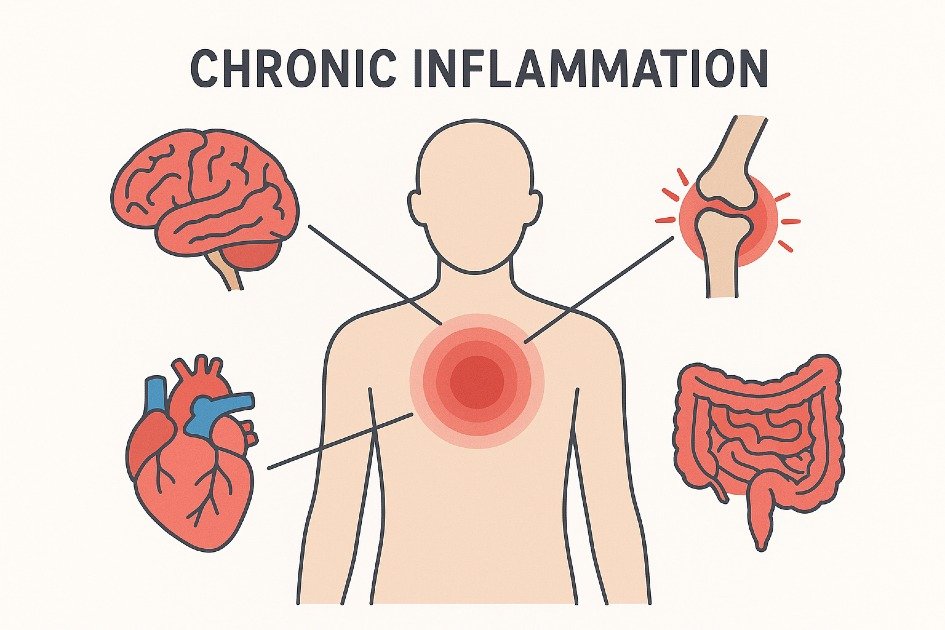
What Inflammation Really Means for Your Health
Inflammation, a natural bodily defense mechanism, can be harmful if left unchecked, and understanding its function and daily choices can help maintain balance.
The Difference Between Acute and Chronic Inflammation
Acute inflammation is the body’s immediate response to injury or infection, often protective and helpful, such as swelling or redness in a sprained ankle or a cut.
Chronic inflammation, a persistent, unrelenting fire, can lead to chronic conditions like arthritis, diabetes, or heart disease, causing the body to wear down over time.
To cool the internal fire, choose anti-inflammatory foods, exercise regularly, reduce stress, and swap sugary snacks for healthier alternatives.
Why Silent Inflammation Is Linked to Fatigue, Pain, and Disease
Silent inflammation, often accompanied by fatigue, achy joints, or brain fog, can lead to serious health issues like heart disease, digestive issues, or autoimmune conditions.
Harvard Health highlights the complex nature of inflammation, which contributes to leading health issues like cardiovascular disease, cancer, type 2 diabetes, Alzheimer’s, allergies, asthma, arthritis, anxiety, depression, and skin conditions.
Tiredness despite sleep may indicate ongoing inflammation in the body. Consuming anti-inflammatory meals like salmon with leafy greens can help restore energy and alleviate joint stiffness.
Start small by replacing soda with green tea, adding colorful vegetables to dinner, and using extra virgin olive oil instead of butter for a noticeable impact.
The Role of Diet in Calming Inflammation Naturally
Consuming sugary, processed, and fried foods can fuel inflammation, while a balanced diet rich in fruits, vegetables, whole grains, and healthy fats can naturally cool the body’s response.
Building an anti-inflammatory plate does not have to be overwhelming; simple, satisfying, and healing meals like oats, quinoa, roasted veggies, chickpeas, or baked salmon can be prepared.
When I cut back on processed foods, I noticed real changes in my body. My bloating went down, my skin looked clearer, and my energy felt steady all day.
Nuts, leafy greens, green tea, and fatty fish are always in my kitchen. These foods fight inflammation and help me feel my best.
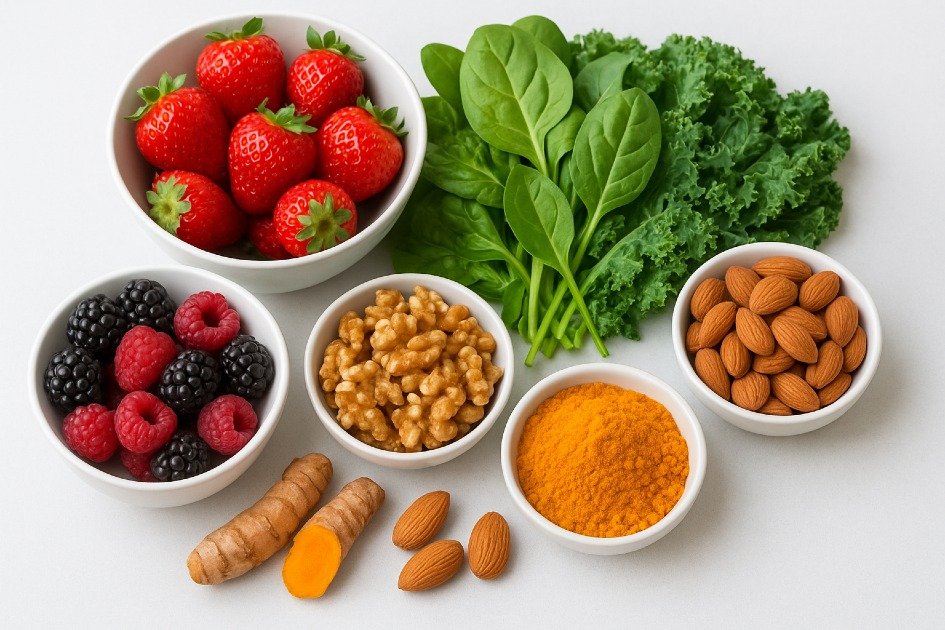
The Science Behind Anti-Inflammatory Eating
Eating anti-inflammatory foods helps the immune system respond by sending calming signals, allowing cells to repair and restore balance, and is practical and doable for everyday life.
How Nutrients Influence Your Immune Response
Poor diet triggers immune system’s alarm, causing inflammation. Refined sugar, fried foods, and processed snacks trigger false alarms, affecting immune system’s response.
Nutrient-dense foods, rich in vitamins and minerals like C, D, and E, help calm the immune system, strengthening defenses without over-exertion, and ensuring only necessary immune cell fights.
Begin with small steps. Toss some spinach into your smoothie or trade chips for crunchy roasted chickpeas. These swaps help your immune system stay balanced and strong.
I started eating more nutrient-rich foods, and within weeks I caught fewer colds and my joints felt less stiff. It was not a quick fix—my body was finally getting the fuel it needed.
The Power of Antioxidants and Phytonutrients
Free radicals, caused by pollution, stress, and poor food choices, damage cells and accelerate aging. Antioxidants and phytonutrients help combat inflammation and protect against these harmful effects.
Antioxidants neutralize free radicals, while phytonutrients provide plant compounds for cell protection. Blueberries, kale, and green tea are excellent examples of antioxidants that combat internal body fire.
Eat a rainbow at every meal. Each color brings unique nutrients that help calm inflammation. Swap white rice for quinoa, or choose fresh berries instead of a cookie.
I saw a real difference when I began keeping antioxidant-rich snacks at my desk. Before, I had hit a slump in the afternoon and fought to stay awake. Now, I stay alert and energized through the day.
Balancing Omega-3 and Omega-6 Fatty Acids
Excessive consumption of omega-6 fatty acids can trigger inflammation, while omega-3s help cool the fire, but most diets today have too much omega-6.
Eat salmon or sardines twice a week or add ground flaxseed to your oatmeal. If you do not enjoy fish, try a trusted omega-3 supplement. At the same time, cut back on fried foods and snacks made with refined oils.
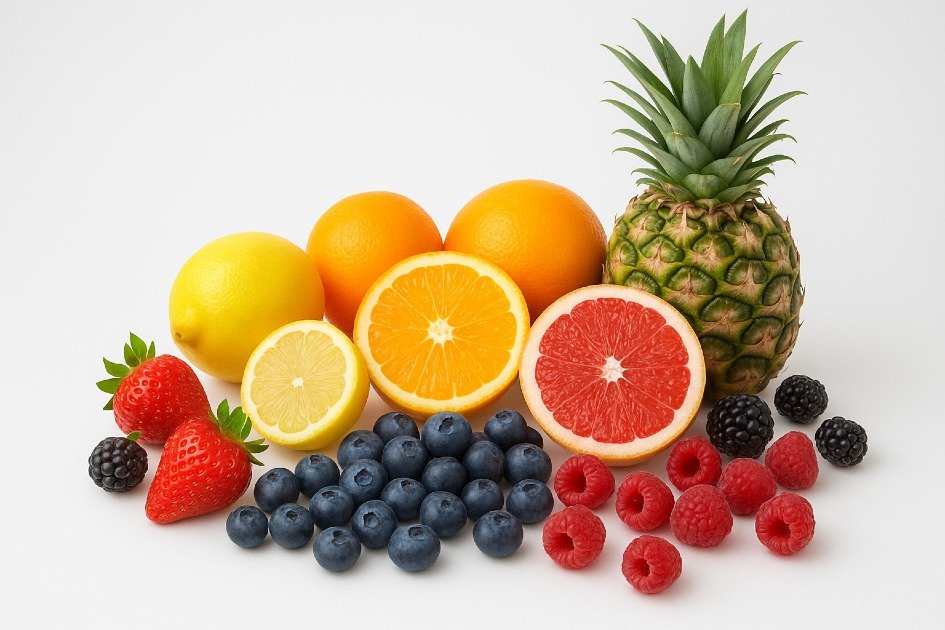
Fruits That Fight Inflammation
Chronic inflammation can be managed by incorporating everyday fruits into your diet, which can provide powerful remedies and support an anti-inflammatory lifestyle, making them a convenient and easy addition to your daily routine.
Berries: Small But Mighty Antioxidant Boosters
Why it matters:
Berries, including blueberries, strawberries, and raspberries, are rich in anthocyanins, which calm oxidative stress, which can lead to chronic inflammation when free radicals overwhelm cells.
How to do it:
- Sprinkle fresh blueberries on your oatmeal or yogurt to boost antioxidants.
- Store frozen berries to make fast, healthy smoothies anytime.
- Try fresh strawberries when you want to eat sweets.
- Enjoy a few fresh raspberries with a square of dark chocolate for a healthy, satisfying treat.
I swapped my afternoon cookie for a bowl of mixed berries. In just a few weeks, I felt lighter, my stomach stayed calm, and my energy lasted until evening.
Pineapple: Nature’s Source of Bromelain for Joint Support
Why it matters:
Pineapple, rich in bromelain, aids digestion and reduces tissue swelling, providing relief for sore joints and post-workout muscle aches.
How to do it:
- Add pineapple chunks to a smoothie with fresh spinach and a hint of ginger for a tasty, nutrient-packed drink.
- Toss fresh pineapple into salads for a juicy, tangy flavor boost.
- Grill pineapple slices and serve them alongside lean protein for a sweet and healthy side.
- Pick fresh or frozen fruits and vegetables to skip added sugar in cans.
When I started adding pineapple to my post-workout meals, I noticed less soreness the next day. Now it is my go-to food during busy training weeks.
Citrus Fruits: Vitamin C Warriors Against Oxidative Stress
Why it matters:
Oranges, lemons, and grapefruits are rich in vitamin C, a potent antioxidant, which aids in immune system function, reduces stress, and promotes skin health.
How to do it:
- Drink warm lemon water in the morning to rehydrate and wake up your body.
- Grab a fresh orange for your afternoon boost instead of reaching for packaged snacks.
- Toss fresh grapefruit slices into your green salad for a bright, zesty flavor.
- Squeeze fresh lime juice over your food instead of using heavy dressings.
I saw my immune health get better when I replaced soda with sparkling water and lemon. The change was small, but my body felt lighter, cleaner, and more refreshed.
Cherry: Natural Relief for Muscle Pain and Restful Sleep
Why it matters:
Cherries, particularly tart cherries, help alleviate inflammation-related joint pain and regulate sleep cycles, thanks to their content of melatonin.
How to do it:
- Sip tart cherry juice after workouts to ease muscle soreness
- Enjoy fresh cherries as a summer snack.
- Mix dried cherries with almonds and pumpkin seeds for a healthy homemade trail snack.
- Stir cherry puree into overnight oats for a soothing breakfast.
I used to toss and turn every night. Then I started drinking tart cherry juice in the evenings. My sleep deepened, and my body recovered faster.
Apples: Everyday Fiber That Feeds a Healthy Gut
Why it matters:
Apples, despite their appearance, contain pectin fiber that supports gut bacteria, which regulates anti-inflammatory responses and maintain digestion, indirectly reducing inflammation triggers.
How to do it:
- Try apple slices with almond butter for a simple, filling snack.
- Bake apples with cinnamon for a cozy treat.
- Toss diced apples into salads for fresh crunch and natural sweetness.
- Eat whole apples instead of juice to get all the fiber your body needs.
I used to snack on chips, but now I am reaching for apple slices with nut butter. It gives me steady energy and keeps me from feeling tired later.
Making Fruits a Daily Anti-Inflammatory Habit
Why it matters:
Calming inflammation requires small, repeatable choices from everyday fruits like berries, pineapple, citrus, cherries, and apples, without overhauling your kitchen.
How to do it:
- Place a fruit bowl where it is easy to see.
- Prep fruit ahead for busy days
- Swap one junk snack for fruit each day
I eat these fruits every day, and I feel my body heal naturally. My digestion is smoother, my energy is higher, and flare-ups happen less often.
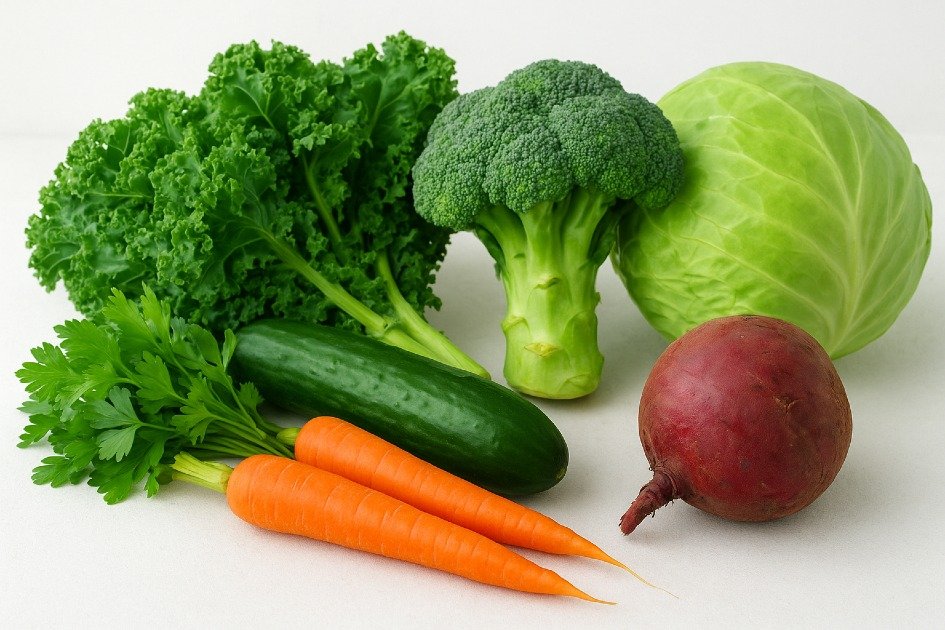
Vegetables That Soothe Your System
Consuming anti-inflammatory vegetables, rich in antioxidants, fiber, and micronutrients, can reduce chronic inflammation, improve digestion, and protect organs, making slight changes in your diet beneficial for long-term health.
Leafy Greens: Your Cellular Armor
Why it matters:
Leafy greens, including spinach, kale, and Swiss chard, are rich in nutrients like vitamin K, magnesium, and polyphenols, which help reduce inflammation, combat fatigue, and improve cardiovascular health.
How to do it:
- Add a handful of spinach or kale to your morning smoothie for an easy boost of vitamins and minerals.
- Toss Swiss chard and arugula together, then drizzle with extra virgin olive oil for inflammation-fighting healthy fats.
- Add garlic and a squeeze of lemon while cooking to keep antioxidants and boost flavor.
I kick off each week by cooking a big batch of lightly sautéed greens. They keep well in the fridge and make it easy to boost any lunch or dinner.
Cruciferous Vegetables: Nature’s Detox Agents
Why it matters:
Broccoli, cauliflower, and Brussels sprouts are rich in glucosinolates, which aid in liver detoxification and reduce inflammation, while their sulfur-containing nutrients neutralize toxins.
How to do it:
- Steaming keeps vegetables full of nutrients, while roasting with turmeric and black pepper boosts their anti-inflammatory power.
- Mix cauliflower rice into stir-fries or salads to add a light, crunchy texture.
- Toss Brussels sprouts in avocado oil and a pinch of sea salt, then oven-roast until crispy for a crunchy, anti-inflammatory snack.
I see my clients feel less bloated and have more steady energy when they eat cruciferous veggies every day. Even just half a cup with each meal can make a real difference.
Sweet Potatoes: Beta-Carotene Packed Comfort
Why it matters:
Sweet potatoes, rich in beta-carotene, vitamin C, and fiber, are an anti-inflammatory alternative to starchy carbs due to their natural sweetness.
How to do it:
- Cut into wedges and roast with cinnamon or paprika for a healthy, nutrient-packed side.
- Choose mashed sweet potatoes instead of regular mashed potatoes; they help keep blood sugar steady and improve gut health.
- Creamy sweet potato soup turns classic comfort food into an anti-inflammatory treat.
I swap sweet potatoes for white potatoes in casseroles and stews. It makes meals healthier and adds bright, appealing color that everyone—kids and adults—enjoys.
Bell Peppers: Colorful Inflammation Fighters
Why it matters:
Bell peppers, rich in vitamin C, carotenoids, and flavonoids, help reduce inflammation and prevent joint pain, promoting a healthy balance of antioxidants.
How to do it:
- Chop red, yellow, and orange peppers to get the most antioxidants in every bite.
- Sautéing in garlic and coconut oil locks in nutrients and boosts flavor.
- Roast in the oven and toss into sandwiches or pasta for a healthy, nutrient-packed boost
I keep a mix of pre-cut bell peppers in my fridge. Having ready-to-eat veggies makes eating anti-inflammatory foods easy every day.
Zucchini and Summer Squash: Gentle Anti-Inflammatory Allies
Why it matters:
Zucchini, a low-calorie, high-fiber summer squash, is rich in carotenoids, supporting gut health, reducing inflammation, and regulating blood sugar levels.
How to do it:
- Brush zucchini slices with olive oil, sprinkle with herbs, and grill until tender.
- Their gentle taste mixes easily and adds more fiber to your diet.
- Swap regular pasta for zucchini noodles to enjoy a low-carb, inflammation-fighting meal.
I always keep pre-cut bell peppers in my fridge. Having grab-and-go veggies makes eating anti-inflammatory foods simple. I love spiralized zucchini—it is fast to make, filling, and helps fight inflammation.
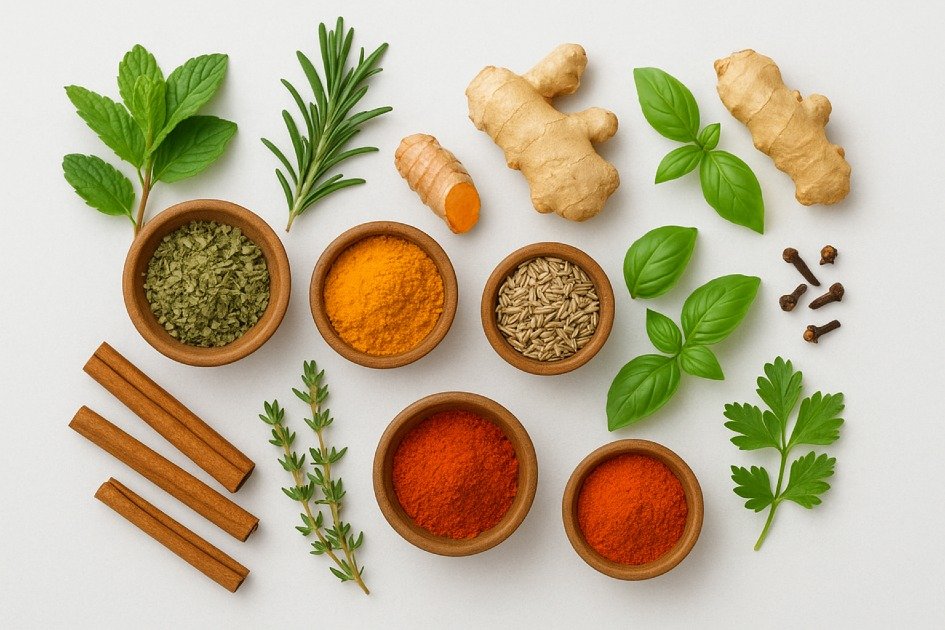
Herbs and Spices That Act Like Natural Medicine
Kitchen herbs and spices are natural anti-inflammatory agents that can improve health by calming inflammation, supporting the immune system, and boosting daily energization.
Turmeric: The Golden Healer
Why it matters:
Turmeric, rich in curcumin, has anti-inflammatory and antioxidant properties, aiding in joint stiffness reduction, muscle soreness alleviation, and cardiovascular health, preventing chronic inflammation that causes fatigue and pain.
How to do it:
- Stir ½ to one teaspoon of turmeric into your soups, stews, or smoothies each day to boost health naturally.
- Add black pepper to turmeric—this helps your body absorb more curcumin.
- Sip warm golden milk at night to relax and fight inflammation naturally.
- Try a top-notch turmeric supplement on busy days when cooking is not an option.
Ginger: Nature’s Gut Soother
Why it matters:
Ginger, rich in gingerol, reduces digestive tract inflammation, relieves bloating, nausea, and gut discomfort, and can boost immunity through regular intake.
How to do it:
- Add freshly grated ginger to teas, stir-fries, or salad dressings for a zesty flavor and natural health boost.
- Start your day with a morning ritual: drink warm ginger water with a splash of fresh lemon.
- Slice ginger and freeze it easily in smoothies or teas anytime.
- Ginger chews or capsules provide quick, convenient anti-inflammatory support anytime.
Garlic: The Immune Defender
Why it matters:
Garlic, rich in allicin, fights inflammation, strengthens immune system, improves heart health by reducing blood pressure and cholesterol, and has natural antimicrobial properties.
How to do it:
- Crush or chop garlic and wait 10 minutes before cooking to boost allicin, the compound that supports heart and immune health.
- Sprinkle garlic on roasted vegetables, mix it into sauces, or stir it into marinades to boost flavor and fight inflammation.
- Take a top-quality garlic supplement to help fight ongoing inflammation.
Cinnamon: Sweet Inflammation Fighter
Why it matters:
Cinnamon, rich in polyphenols, combats oxidative stress, regulates blood sugar, reduces inflammatory stress, and supports overall metabolic health.
How to do it:
- Add cinnamon to your oatmeal, coffee, or baked treats to help fight inflammation every day.
- Stir into smoothies or yogurt to add natural flavor without extra sugar.
- Steep cinnamon sticks in hot tea to make a soothing, inflammation-fighting drink.
How to Use Anti-Inflammatory Herbs and Spices
Why it matters:
Integrating herbs and spices into daily meals can enhance your natural anti-inflammatory defense, making small, consistent changes more effective than occasional large doses.
How to do it:
- Display your spice jars where you can see and reach them easily while cooking.
- Try swapping salt or sugar with anti-inflammatory herbs and spices to boost flavor and support your health.
- Mix herbs such as turmeric, ginger, and cinnamon to boost their effects together.
- Switch up your spices each week to make meals tasty and boost nutrition.
I add anti-inflammatory herbs and spices to my meals every day. They boost my health, support long-term wellness, and help my body stay calm.
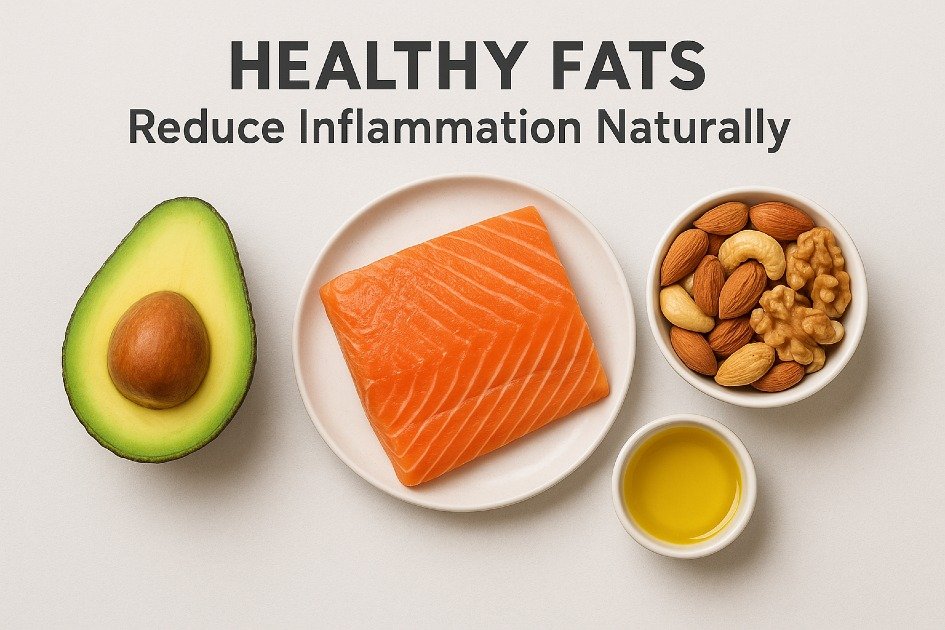
Healthy Fats That Cool Inflammation
Different fats can either promote or counteract inflammation, making healthy fats a crucial part of a balanced diet for long-term well-being, and easy to incorporate into your diet.
Fatty Fish: Omega-3 Powerhouses
Why it matters:
Fatty fish, such as salmon, sardines, and mackerel, are rich in omega-3 fatty acids, which reduce inflammation, support heart health, and promote brain function.
How to do it:
- Eat salmon or sardines two times a week to fight inflammation and protect your heart.
- Skip frying to keep harmful oils from triggering inflammation.
- Top a salad with blueberries and salmon or enjoy sardine toast with avocado for a tasty, nutrient-packed meal.
- Try a high-quality omega-3 supplement on days you cannot eat fish.
Olive Oil: Liquid Gold for Your Cells
Why it matters:
Extra virgin olive oil, rich in monounsaturated fats and polyphenols, is an antioxidant that neutralizes free radicals, reduces inflammation, and supports vascular health.
How to do it:
- Drizzle olive oil over salads, roast veggies with it, or brush it on grilled meat for flavor and health benefits.
- Heat can destroy many polyphenols, so using them cold keeps their benefits strong.
- Swap butter or margarine for a teaspoon of olive oil when cooking to make your meals healthier and support heart health.
Nuts and Seeds: Crunchy Anti-Inflammatory Boosts
Why it matters:
Nuts and seeds, rich in healthy fats, magnesium, and fiber, provide anti-inflammatory support, stabilize blood sugar, and reduce oxidative stress, making them a convenient and convenient choice.
How to do it:
- Sprinkle chia seeds on yogurt, oatmeal, or salads to boost your nutrition.
- Different nuts have different polyphenols—eat many kinds to get the most benefits.
Avocado: Creamy, Anti-Inflammatory Superfruit
Why it matters:
Avocados, rich in monounsaturated fats, vitamin E, and carotenoids, aid in reducing inflammatory markers and oxidative damage, supporting heart, skin, and satiety.
How to do it:
- Try spreading half an avocado on your morning toast or blending it into your smoothie for a creamy, nutrient-rich boost.
- Try spreading avocado on your sandwiches instead of mayonnaise or butter
- Add leafy greens or tomatoes to boost your meal’s nutrients.
How to Make Healthy Fats Work for You
Why it matters:
Understanding the right fat and their inclusion can effectively manage inflammation without complicating your diet, with small, consistent changes having a cumulative impact.
How to do it:
- Plan one meal with fatty fish, one dish with avocado, and include several nuts snacks each week.
- Swap out inflammatory oils like canola or vegetable oil for heart-healthy olive oil in every meal.
- Healthy fats are high in calories. Stick to a small handful of nuts or one tablespoon of olive oil at a time.
I add healthy fats like avocado and walnuts to my meals. They ease my stiff joints, give me more energy, fight inflammation, strengthen my immunity, and keep me feeling strong, all while I adjust my diet gradually.
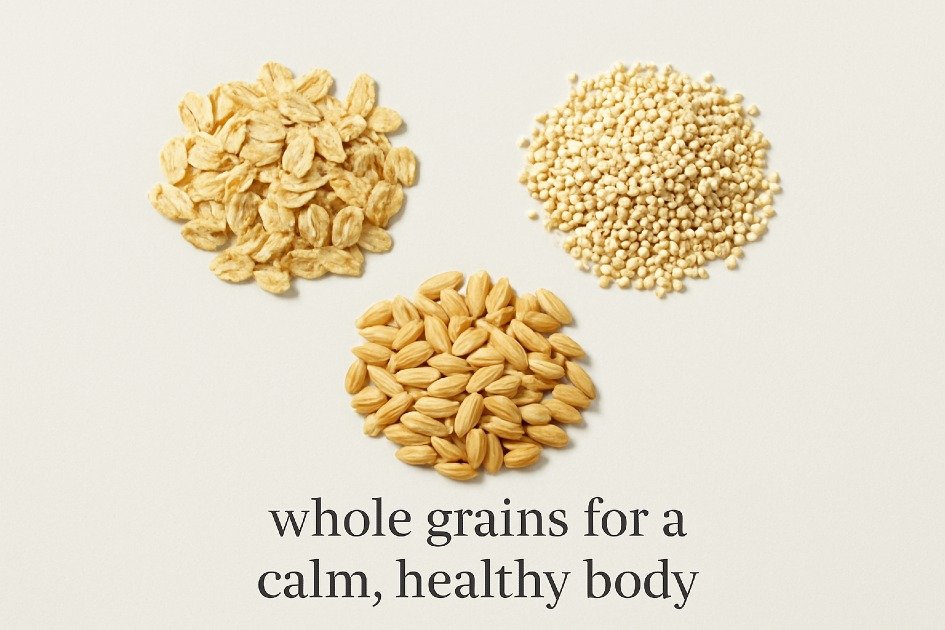
Whole Grains That Calm Your Body
Whole grains, rich in fiber, antioxidants, and nutrients, can naturally reduce inflammation, stabilize blood sugar, promote gut health, and enhance mood.
Oats: The Gentle Anti-Inflammatory Breakfast Hero
Why it matters:
Oats, rich in beta-glucan, lower inflammatory markers, improve gut health, support heart health, and stabilize blood sugar, preventing inflammation spikes.
How to do it:
- Enjoy a warm bowl of steel-cut oats in the morning, topped with nuts and seeds to fuel your body and fight inflammation.
- Try adding berries or a small scoop of superfood powder to boost your antioxidants.
- Choose plain oats instead of flavored packets to cut hidden sugars that fuel inflammation.
Quinoa: The Protein-Packed Grain That Heals
Why it matters:
Quinoa, a gluten-free protein with nine essential amino acids, aids in tissue repair, reduces gut irritation, and is rich in magnesium and manganese, supporting oxidative stress enzymatic reactions.
How to do it:
- Swap white rice with cooked quinoa in salads, stir-fries, or bowls for more protein, fiber, and lasting energy.
- Swap regular oats with quinoa flakes in your morning porridge or baked goods to boost anti-inflammatory nutrition.
- Grab quinoa snack bars for a quick, anti-inflammatory boost on the go.
Brown Rice: Steady Energy Without the Inflammatory Spike
Why it matters:
Brown rice, rich in fiber, vitamins, and minerals, has a low glycemic index, preventing blood sugar spikes and promoting anti-inflammatory choices in any meal.
How to do it:
- Make a big pot of brown rice and keep it in airtight containers.
- Combine brown rice with broccoli or leafy greens for a simple, anti-inflammatory meal that supports better health.
- Swap pasta or white grains with brown rice to fight inflammation and still enjoy a filling meal.
Barley and Farro: Ancient Grains for Modern Wellness
Why it matters:
Barley and farro are rich in fiber, lignans, and slow-digest carbohydrates, which reduce inflammatory responses, provide steady energy, and support gut microbiome diversity.
How to do it:
- Toss cooked grains with fresh herbs, a squeeze of lemon, and heart-healthy olive oil for a simple anti-inflammatory salad.
- Stock your pantry with ancient grain blends for quick, easy, and anti-inflammatory meals.
How to Make Whole Grains a Daily Habit
Why it matters:
Whole grains daily intake can reduce chronic inflammation, and small, sustainable changes can prevent overwhelm and increase long-term adherence.
How to do it:
- Replace refined grains with whole grains in one meal each day to start small and build a lasting habit.
- Stock your pantry with different whole grains to enjoy a mix of tastes and textures.
- Mix whole grains with anti-inflammatory herbs and veggies to make a meal that soothes your body.
I fill my plate with whole grains to keep my body strong, fight inflammation, and stay full of energy. I add herbs and spices like nature’s medicine to boost these benefits and feel my best every day.
Recap: Eat to Calm, Heal, and Thrive
An anti-inflammatory lifestyle can lead to increased energy, less discomfort, and a healthier body.
By incorporating anti-inflammatory foods like berries, leafy greens, omega-3 packed fish, and turmeric, you are investing in your body’s future.
Even small, consistent choices can transform chronic stress and inflammation into vitality and ease.
These foods function as allies, moderating oxidative stress, supporting joint health, and fortifying the immune system.
By choosing anti-inflammatory ingredients, you are orchestrating a symphony of healing at a cellular level, amplifying life quality, mental clarity, and overall wellness. It is sustainable and can be enjoyed daily.
Frequently Asked Questions
Can anti-inflammatory foods replace medication for chronic inflammation?
Anti-inflammatory foods can reduce inflammation but not replace prescribed medications. Combining diet with lifestyle adjustments like turmeric supplements, exercise, and stress management can provide relief.
How long does it take to notice the benefits of an anti-inflammatory diet?
Consistency in daily consumption of berries, leafy greens, fatty fish, and anti-inflammatory herbs can lead to improvements in energy, digestion, and joint comfort over 2-4 weeks.
Are all fats harmful to inflammation?
Healthy fats like salmon, chia seeds, walnuts, and olive oil are anti-inflammatory, supporting cardiovascular and cellular health. High-quality fish oil supplements can be beneficial for limited intake.
Is coffee considered anti-inflammatory or inflammatory?
Moderate coffee consumption is anti-inflammatory due to polyphenol content, but excessive intake can trigger mild inflammatory responses. Green tea or herbal alternatives offer gentler effects.
Do anti-inflammatory foods help with weight management?
Anti-inflammatory foods like quinoa, leafy greens, fatty fish, and berries regulate blood sugar, support metabolism, and reduce inflammation. Combining these with metabolism-boosting supplements can improve weight management.
Can anti-inflammatory foods improve skin and gut health?
Chronic inflammation can cause skin and gut issues. Consuming antioxidant-rich foods, prebiotics, and fiber can improve skin and gut health, while probiotics can optimize gut balance.
How can I make my daily meals more anti-inflammatory without drastically changing my lifestyle?
Small, strategic swaps like incorporating extra virgin olive oil, nuts and seeds, turmeric, ginger, and colorful fruits and vegetables can significantly reduce systemic inflammation over time.

